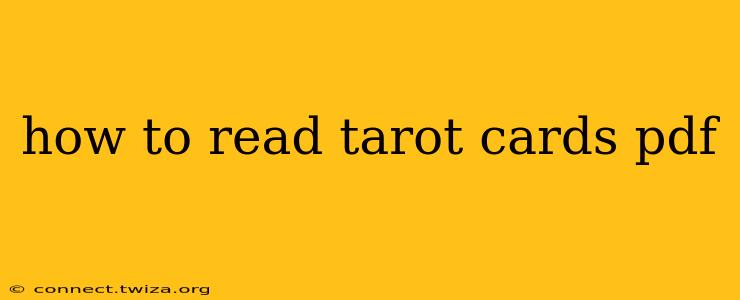Learning to read tarot cards is a journey of self-discovery and intuition. This guide will walk you through the essential steps, from choosing your deck to interpreting complex spreads. While this guide won't provide a downloadable PDF, the information below will equip you with the knowledge to begin your tarot practice.
What You'll Need to Get Started
Before diving into interpretations, you'll need a few key items:
-
A Tarot Deck: Choose a deck that resonates with you. There are countless variations, from classic Rider-Waite-Smith decks to more modern and artistic interpretations. The imagery is crucial, so select a deck whose artwork speaks to you. Don't be afraid to browse different decks until you find one that feels right.
-
A Guidebook (Optional but Recommended): Many decks come with a companion guidebook explaining the meanings of each card. This can be incredibly helpful, especially when starting. However, remember that guidebooks offer suggestions – ultimately, your intuition is the most important tool.
-
A Journal: Keep a journal to record your readings, your intuitive insights, and your reflections on the cards. This helps track your progress and develop your understanding.
-
A Quiet Space: Find a peaceful and comfortable space where you can focus without distractions.
Understanding the Structure of a Tarot Deck
A standard tarot deck consists of 78 cards, divided into two main sections:
-
Major Arcana (22 cards): These cards represent major life lessons, archetypes, and significant life events. They often depict powerful figures and symbolic imagery with profound meaning.
-
Minor Arcana (56 cards): These cards represent everyday experiences, emotions, and situations. They are divided into four suits, similar to playing cards: Wands (fire, action), Cups (water, emotions), Swords (air, intellect), and Pentacles (earth, material world). Each suit has numbered cards (Ace through Ten) and four court cards (Page, Knight, Queen, King).
How to Shuffle and Choose Cards
-
Center Yourself: Before shuffling, take a few deep breaths and focus your intention. What question are you asking the cards? Clarify your intent.
-
Shuffle Intuitively: Shuffle the cards thoroughly. Don't just perform a perfunctory shuffle; engage with the process. Let your intuition guide the way.
-
Cutting the Deck: Once you've shuffled, cut the deck into three piles. This is a symbolic act of separating and then reuniting the energies. Recombine the piles.
-
Drawing Cards: Depending on the spread you're using (more on spreads below), you'll draw a specific number of cards. Pay attention to which cards you draw and how they feel in your hand.
Common Tarot Spreads
A spread is a pattern in which you lay out the cards. Here are a few popular spreads:
-
One-Card Draw: Simple and direct, ideal for a quick answer to a specific question.
-
Three-Card Spread (Past, Present, Future): Provides insight into the past influences, current situation, and potential future outcomes.
-
Celtic Cross Spread: A more complex spread offering detailed insights into various aspects of a situation.
Interpreting the Cards: It's More Than Just Keywords!
Each card has keywords associated with it, but don't limit yourself to just those. Pay attention to:
-
The imagery: What do you see in the card? What emotions does it evoke?
-
The colors: What is the overall feeling conveyed by the colors used in the card's artwork?
-
Your intuition: What does the card feel like to you? Trust your gut feeling.
Understanding Upright vs. Reversed Cards
Many tarot readers interpret cards in both upright and reversed positions. Reversed cards often signify a shadow aspect of the card's meaning – a challenge, a blockage, or an internal struggle. However, some readers don't use reversed cards, focusing solely on the upright meanings. The choice is yours.
Developing Your Intuition: Practice Makes Perfect!
Reading tarot cards is a skill that develops over time. The more you practice, the stronger your intuition will become. Don't be discouraged if you feel uncertain at first. The journey is as important as the destination.
Frequently Asked Questions (FAQ)
What is the best tarot deck for beginners?
There's no single "best" deck. The Rider-Waite-Smith deck is a popular choice due to its clear and consistent imagery, making it a good starting point. However, ultimately, choose a deck that you are drawn to visually.
How accurate are tarot card readings?
Tarot cards are a tool for self-reflection and gaining insights, not fortune-telling. The accuracy of a reading depends on the reader's intuition and interpretation, as well as the querent's (the person asking the question) willingness to be open to the messages.
Can anyone learn to read tarot cards?
Yes! Anyone with an open mind and a willingness to learn can develop the skills to read tarot cards. It takes practice and patience, but the rewards are well worth the effort.
What if I draw a card with a negative meaning?
Don't be afraid of negative-seeming cards! They often highlight challenges or areas for growth. They are not necessarily predictions of doom but rather opportunities for reflection and change. The cards often provide guidance on how to navigate difficulties.
This comprehensive guide provides a solid foundation for your tarot journey. Remember, practice, intuition, and a willingness to learn are key to mastering this ancient art.
